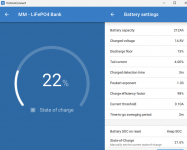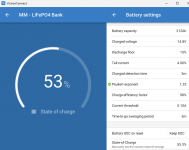You are using an out of date browser. It may not display this or other websites correctly.
You should upgrade or use an alternative browser.
You should upgrade or use an alternative browser.
What did you do to your van today?
- Thread starter Vanterrier
- Start date
Tim120
Full Member
- Messages
- 433
I've read of this before and no idea why it happens. I had mine (460 fogstar) in it's original box sat on a cold garage floor with no discharge whatsoever, don't know the answer to that.i’d had it at home for 6 weeks on the cold garage floor and it had completely discharged !
I think the fogstar BMS will stop a complete discharge and so protect itself.
Tim120
Full Member
- Messages
- 433
Is that true for any BMS or that one in particular?TBH, I would not trust the reported SOC (State of Charge) to be correct on those batteries, so both your batteries could have behaved the same in reality, but the BMS just reported wrong.
wildebus
Full Member
- Messages
- 7,779
I have just seen so many reports of the Fogstar, the KS Energy and one other brand that eludes me where the SOC from the BMS jumps up and down randomly, I could not just trust it.Is that true for any BMS or that one in particular?
One of these brands actually recommended using a Victron BMV monitor for more accurate info!
The Lithium Batteries that I have now and in the past, both which were admittedly much more pricey, have had a BMS where the SOC has always been accurate.
rugbyken
Full Member
- Messages
- 1,620
this was before we had connected anything to the battery jeff used his monitor and it read zero now up to 458.5 so going to set the victron shunt at that , i do like that the app shows amps etc much easier for a luddite like me to understand but with both the victron & the drift giving me information i’ll be completely confused nowTBH, I would not trust the reported SOC (State of Charge) to be correct on those batteries, so both your batteries could have behaved the same in reality, but the BMS just reported wrong.
wildebus
Full Member
- Messages
- 7,779
Of the two, I would trust the Victron more. You will need to change some settings on the Victron BMV though. The capacity you have already done, but there is also another one you may need to.this was before we had connected anything to the battery jeff used his monitor and it read zero now up to 458.5 so going to set the victron shunt at that , i do like that the app shows amps etc much easier for a luddite like me to understand but with both the victron & the drift giving me information i’ll be completely confused now
In the same page as the battery capacity, there is a "peukert exponent" value that would be set at a lower value than for lead. (I can't remember if your BMV was setup just for the Lithium battery or for the Hybrid battery in its entirety?). I have mine set at 1.03, whereas for the Lead Carbon I use 1.08. Those settings seem to work quite well.
wildebus
Full Member
- Messages
- 7,779
Try it at 1.03.i saw the peukert exponent on the set up had no idea what it was so left it alone , since you posted it i had a look and it’s set for 1.25 what would you recommend for entirely lithium set up ?
For more info ......
Briefly (sort of!), the number selected affects the estimated capacity of the battery at different load levels. With Lead Batteries, the higher the current drawn, the more the capacity is affected (lowered). The manufacturers show how much in their spec sheets - for example a Battery which is described as a 110AH Battery may also be described as a 95AH Battery depending on if you read the "C100" or the "C20" values - a smaller "C" relates to a higher average current being drawn. That effect is known as the Peukert effect and the Peukert exponent says just how much the battery is affected.
Some Manufacturers actually quote a value for their batteries; Others supply a comprehensive set of discharge tables at different loads which can be used to work it out; Others (the most common significantly) you just have to guess at.
The Victron monitors apply this exponent in their calculation of the SOC. Each 'capture' of the current drawn affects the SOC value and that affect is adapted by the Peukert exponent, where the greater the current, the greater the impact of this (it is not a linear adjustment).
You will see something interesting happening when you change it, and how much change you see will depend on what kind of loads you have had on the battery.
This is what Victron tells me my Lithium Battery Bank is when the Peukert Component is set at 1.03

I am good with that as I when I check what the Lithium Batteries own BMS SOC Monitors says about the SOC, I see 22% on one and 21% on the other, so they are well balanced between each other and within 1% of the Victrons value.
So for MY batteries, I reckon 1.03 is pretty well spot-on.
If I were to change the Peukert exponent to 1.25, as yours is currently set to, just check what happens to the SOC!

A very dramatic difference!
Since the last full charge, I have have very low levels of current draw. It has been constant and on-going, but very low, with the peak probably being around at a C100 level, so the Victron BMV has worked out the 'real' SOC is much greater due to the low load based on the Peukert exponent value.
However, Lithium Batteries are affected much less by high currents, so a low current is of no benefit to them any more than a high current 'hurts' them.
In terms of External SOC monitors, the Victron ones are the only ones I am personally familiar with that have this adjustment. The Alii Monitor, which is a popular one, does not and I don't think the Renogy ones (rebadged TKxx?) don't either, or the NASA Range as far as I recall.
For the Internal Monitors, I doubt very much if they have a Peukert adjustment, not least as it is much less impactful for Lithium so they probably would not want to add the complexity. But it does mean a Monitor like a Victron BMV, when configured right, can be more accurate.
Oh - and there is a 3rd adjustment to look at ... the Charge Efficiency Factor. A Lead Battery is less efficient at converting the current from a charger into stored battery power. The Charge Efficiency Factor takes that into account. If say you had it set to 90%, for each 10A the Victron Monitor saw coming INTO the battery, it would assume only 9A will be stored in the battery. This will impact how fast the SOC rises on charge. If the Charge Efficiency is wrong, then the SOC will rise too fast (efficiency is set higher than it should) or too slowly (set lower than it should be).
Lithiums are efficient converters of charge, so should be set pretty high. Spec Sheets for the battery might give that info sometimes. I have mine set to 98% on the Lithium and 95% on the Lead.
With all these factors to consider, it is not surprising SOC monitors (external OR internal) may not be exactly what the real situation is with the battery. It is not like a fuel gauge where you are seeing from a float position exactly how much fuel is left, but more like a "distance to empty" number on a trip computer.
Last edited:
wildebus
Full Member
- Messages
- 7,779
I think 1.05 for Lithium is a good defaultCan’t remember where I got the setting from now but I set mine for 1.05 for full lifepo4. It’s been working accurately for over 4 years now on that setting so must be close
I could well have set it to that initially and then fine-tuned to 1.03 after a while comparing Battery BMS SOCs to Victron BMV SOC?
saxonborg
Full Member
- Messages
- 1,138
Does snow foam work then?Neither of us is physically up to cleaning the van now, particularly the roof, so in a fairly short time this is the result.
View attachment 70638
Today we got a mobile valeter in with very pleasing results.
View attachment 70639View attachment 70640View attachment 70641
2cv
Moderator
- Messages
- 7,286
Apparently it does. I was certainly very pleased with the results. Whilst the roof was obviously worst before cleaning other parts too were quite bad.Does snow foam work then?
Users who viewed this discussion (Total:63)
AlyJay,
Landyseverywhere,
saxonborg,
Rogerdodger,
Exwindsurfer,
2cv,
GeoffL,
AllanD,
TeamRienza,
The laird,
marchie,
HurricaneSmith,
Obanboy666,
wildebus,
FIJIT,
Ted,
Pudsey Bear,
s4x4c,
John and Enid,
Geek,
Mr and Mrs Tupcox,
rugbyken,
edina,
Bigshug,
Rosehip,
Rumour,
Greengrass,
Donny Mac,
RegnVal,
Chipvan,
gasgas,
exmusso,
RSD7a,
trevskoda,
Sonar,
Lee,
Burge,
bjh,
Scotia,
bartman,
Trotter,
Stonedaddy,
mendit,
runnach,
helmit,
Bouydog,
Boris7,
Livotlout,
Owen1953,
jiwawa,
merl,
Fifer,
Robmac,
BunnyB,
TissyD,
Hiraeth,
Aycee,
Fergie1061,
Molly 3,
RoaminRog,
Phantom,
Mberry,
MJK,





